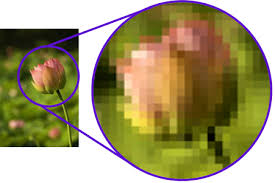Marketing Basics: Artwork – Raster vs. Vector
Most people think a picture is a picture. You have jpg, gif, and so on. In the marketing and advertising world, pictures are so much more. The right visual can make or break an advertisement and no business wants their logo to appear blurry or unprofessional. When we have an order from a client, we always ask for a vector logo as the method of imprint, but how many actually know what a vector graphic is?
Most images online are considered Raster Graphics. A raster image is comprised of many (hundreds, thousands, or even millions) tiny squares of color, a.k.a. pixels. The most common form of raster graphic is a picture or photo (jpg/jpeg, psd, png, tiff, bmp, and gif). These types of images are mostly altered and edited by programs such as Photoshop.
Raster images are great to have because they offer a depth of detail. High resolution images are vivid and capture great detail in the photograph. This images are measured in resolution by dpi (dots per inch). Most raster images used in promotions need to be a minimum of 300 dpi to print clear and crisp. This means that for a 1″x1″ area there are 300 individual pixels making up that area. The fewer dpi in an image, the less detailed an image will be.
The biggest downfall to raster images is that they become pixelated (blurry or grainy) when enlarged. When you enlarge a photo, the computer speculates what colors it should use to fill in the gaps in the dots as you enlarge the image. This interpolation of data creates the blurriness since the computer has no way of knowing exactly what shades of color should be inserted between the dots.
This is why we use vector graphics in most of our printed products and advertising materials. A vector image uses math to draw shapes using points, lines and curves. While a raster image 1″x1″ at 300 dpi will have 300 individual pieces of information (i.e. the pixels), a vector graphic will only contain four points, one for each corner and the computer will use math to “connect the dots” and fill in the missing information.
Vectors are most commonly used for fonts and logos and are created using graphic design software, such as Adobe Illustrator or Corel Draw. The most common vector file extensions are eps, ai and pdf.
Vectors are the ideal media for marketing and advertising because they are infinitely scalable. They can be scaled up or down as much as you want without losing any image quality, whereas raster images must guess the colors of the missing pixels when sizing up. Vectors are also smaller files. Comparing a vector and raster the same measurable size side by side, the vector is a much smaller file because it is points with lines and curves, versus several hundred or thousand pixels filling the same size area. Vector graphics are also more editable. When you open a vector file, the original shapes exist separately on different layers, unlike raster – which is a flattened image. It should also be noted that when you finalize a vector graphic, any fonts need to be converted to outlines or curves because the final person receiving that file may not have that font downloaded on their computer and will not be able to open the file correctly because of that font. Converting the font to vector curves eliminates this problem and makes it universally able to be opened despite the fonts available on a receiver’s computer.
The advantages of vector images are also the reason it has some drawbacks. Because of the mathematical way a vector is created, they are not practical for complex images. By definition, vectors are created from simple points and lines. This means they can’t handle certain styling effects, like blurring or a drop shadow, which raster is capable of.







Comments
Post a Comment